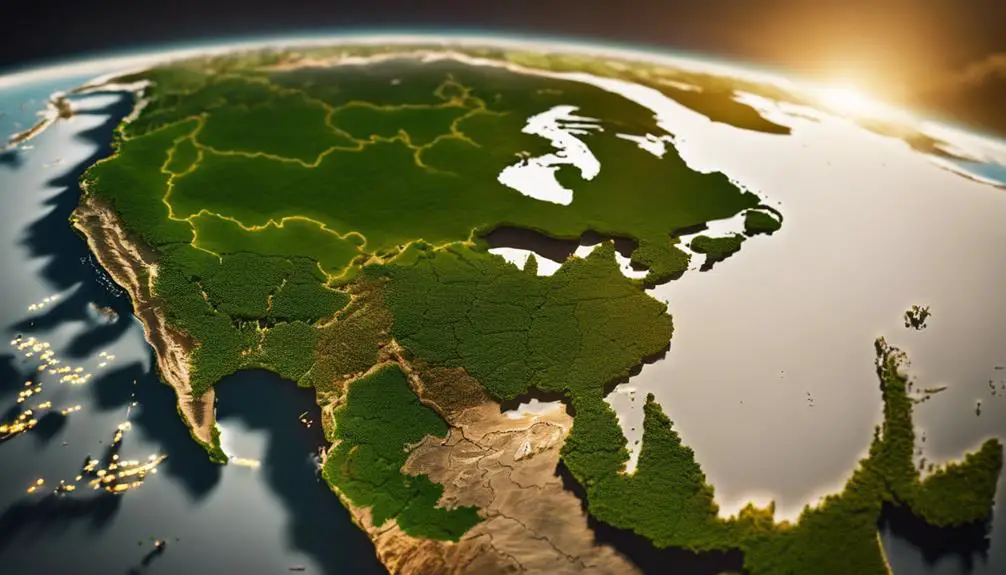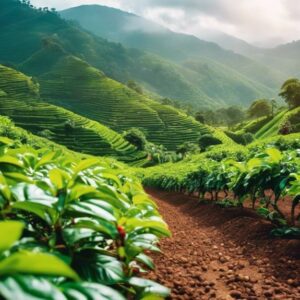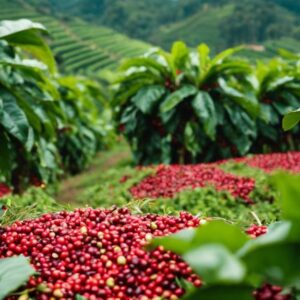Embark on a journey through the intricate web of Arabica coffee growing regions, akin to uncovering hidden gems on a treasure map.
As you navigate through these lush landscapes, each region holds a unique story waiting to be told. From the misty mountains to the sun-kissed valleys, the tapestry of flavors woven by terroir awaits your exploration.
But what secrets lie within these key areas, and how do they shape the world’s most beloved coffee bean? Let’s unravel the mysteries together.
Unveiling the Premier Arabica Coffee Growing Regions

When it comes to Arabica coffee growing regions, you’ll discover that Latin America stands out as the powerhouse of this beloved bean.
Africa takes its place as the cradle of coffee, boasting a rich history and unique flavors.
Lastly, Asia & Oceania offer a diverse range of microclimates, creating a mosaic of growing conditions for Arabica coffee.
Latin America: The Powerhouse of Arabica Coffee
Latin America stands as the powerhouse of Arabica coffee, boasting premier growing regions that showcase a diverse tapestry of flavors and innovation.
As you explore this region’s coffee landscapes, envision Brazil’s rich variety of coffee types and processing methods, Colombia’s dedication to sustainability and quality, and Costa Rica’s leadership in environmental stewardship and technology.
Delve into Guatemala’s intricate microclimates shaping distinct flavors and Honduras’ rapid ascent in the specialty coffee realm. Immerse yourself in the richness of Latin America’s coffee heritage.
- Brazil: A Rich Tapestry of Coffee Varietals and Processing Methods
- Colombia: Innovation in Sustainability and Quality
- Costa Rica: Leading the Way in Environmental Stewardship and Coffee Technology
- Guatemala: The Complexity of Microclimates and Their Influence on Flavor
- Honduras: Rapid Growth in Specialty Coffee Production
Brazil: A Rich Tapestry of Coffee Varietals and Processing Methods
Amidst the vibrant landscapes of Brazil’s coffee-growing regions, a rich tapestry of diverse coffee varietals and innovative processing methods unfold, showcasing the country’s unparalleled contribution to the world of Arabica coffee. Brazil is home to a wide array of coffee varieties, each offering unique flavor profiles.
The innovative processing methods utilized in Brazil further enhance the quality and distinctiveness of their coffee beans.
| Varieties | Processing Methods | Innovation |
|---|---|---|
| Bourbon | Natural | Pulped Natural |
| Catuai | Washed | Honey Process |
| Mundo Novo | Semi-washed | Anaerobic Fermentation |
Colombia: Innovation in Sustainability and Quality
Innovating in sustainability and quality, Colombia stands out as a premier Arabica coffee growing region within Latin America, showcasing its commitment to excellence in coffee production.
By implementing sustainable practices and focusing on quality, Colombian coffee producers ensure a premium product that satisfies both your taste buds and your eco-conscious mind.
| Sustainability | Quality |
|---|---|
| Eco-friendly farming methods | High-altitude cultivation |
| Fair trade practices | Strict quality control |
| Water conservation efforts | Specialty coffee varieties |
Costa Rica: Leading the Way in Environmental Stewardship and Coffee Technology
Costa Rica sets the standard for environmental stewardship and coffee technology, exemplifying excellence in Arabica coffee production in Latin America. In Costa Rica, sustainability practices and advanced coffee processing techniques converge to create exceptional brews.
Costa Rican farmers prioritize eco-friendly methods, ensuring the preservation of their lush landscapes. By embracing innovation and environmental stewardship, Costa Rica continues to lead the way in the coffee industry.
| Innovations | Sustainability | Technology |
|---|---|---|
| Eco-friendly farming | Rainforest preservation | Advanced processing |
| Shade-grown techniques | Biodiversity conservation | Quality control systems |
| Solar energy utilization | Water resource management | Precision harvesting |
| Carbon footprint reduction | Soil health maintenance | Automated sorting |
| Organic farming methods | Waste reduction strategies | Data analytics for yield optimization |
Guatemala: The Complexity of Microclimates and Their Influence on Flavor
Exploring the intricate tapestry of Guatemala’s microclimates reveals the profound impact they have on the nuanced flavors of Arabica coffee grown in the region. These diverse microclimates create a spectrum of flavors, from fruity and floral to chocolatey and nutty notes.
Discover how the altitude, rainfall, and temperature variations in Guatemala contribute to the unique taste profiles found in its Arabica coffees.
| Altitude | Rainfall | Temperature |
|---|---|---|
| High | Moderate | Varies |
| Low | High | Consistent |
| Medium | Low | Fluctuating |
Honduras: Rapid Growth in Specialty Coffee Production
Honduras has emerged as a key player in the specialty coffee industry, experiencing rapid growth in production and establishing itself as a premier Arabica coffee growing region in Latin America.
With innovative farming techniques and a focus on specialty beans, Honduras has seen a surge in the number of farms dedicated to producing high-quality coffee. The country’s commitment to excellence is reshaping the coffee landscape.
| Innovative Farming Techniques | Focus on Specialty Beans | Surge in Number of Farms |
|---|---|---|
| Yes | Yes | Yes |
Africa: The Cradle of Coffee
When it comes to Africa, the premier Arabica coffee growing regions are full of unique stories and flavors waiting to be discovered. Get ready to explore the diversity and richness of coffee production in countries like Ethiopia, Kenya, Rwanda, and Tanzania. Experience the following vibrant elements of these regions:
- Ethiopia: Diversity of Heirloom Varietals and Unique Processing Methods
- Kenya: Advanced Agricultural Practices and Auction System
- Rwanda: Post-Conflict Renaissance and Focus on Specialty Coffee
- Tanzania: The Role of Peaberry Varietals in Coffee Quality
Ethiopia: Diversity of Heirloom Varietals and Unique Processing Methods
Nestled in the heart of Africa, Ethiopia stands out for its rich tapestry of heirloom coffee varietals and traditional processing methods that distinguish it as a premier Arabica coffee growing region.
Ethiopian coffee is renowned for its diverse flavors and unique profiles due to the varied heirloom varietals cultivated in the region. The traditional processing methods further enhance the distinctiveness of Ethiopian coffee.
| Heirloom Varietals | Unique Processing Methods | Special Characteristics |
|---|---|---|
| Sidamo | Washed | Floral and Citrus Notes |
| Yirgacheffe | Natural | Fruity and Winey |
| Harrar | Honey Process | Blueberry and Spice |
| Limu | Sun-Dried | Balanced and Sweet |
Kenya: Advanced Agricultural Practices and Auction System
Kenya’s Arabica coffee growing regions are distinguished by their advanced agricultural practices and a unique auction system that sets them apart in the world of specialty coffee. The management practices in Kenya focus on precision and innovation, ensuring high-quality coffee beans. The auction system enhances transparency and fair pricing.
See the table below for a brief overview:
| Management | Practices | Innovation |
|---|---|---|
| Precision | Quality | Transparency |
Rwanda: Post-Conflict Renaissance and Focus on Specialty Coffee
With a renewed focus on specialty coffee following a period of conflict, Rwanda’s coffee industry is experiencing a renaissance driven by innovation and quality. Rwanda has embraced specialty coffee production, enhancing its global reputation.
The country’s unique microclimates contribute to the distinct flavors found in its beans. Rwandan coffee is known for its bright acidity, floral notes, and a velvety mouthfeel, attracting coffee enthusiasts worldwide.
| Specialty Coffee Innovations in Rwanda |
|---|
| Direct Trade Partnerships |
| Sustainable Farming Practices |
| Cupping Competitions |
| Coffee Tourism Initiatives |
Tanzania: The Role of Peaberry Varietals in Coffee Quality
After exploring Rwanda’s specialty coffee success story, turn your attention to Tanzania, where the focus shifts to the unique contribution of Peaberry varietals in enhancing coffee quality in this premier Arabica coffee growing region of Africa.
Asia & Oceania: A Mosaic of Microclimates
As you explore the diverse landscapes of Asia & Oceania, you’ll uncover a rich tapestry of microclimates that influence the flavors of Arabica coffee beans. In Indonesia, the processing methods wield a direct impact on the intricate flavor profiles.
Yemen stands as a guardian of ancient coffee cultures amidst modern advancements. Get ready to navigate the challenges and opportunities in organic coffee production in Papua New Guinea and witness the emerging trends in Arabica cultivation in Vietnam.
- Indonesia: The Impact of Processing Methods on Flavor Profiles
- Yemen: Preserving Ancient Coffee Cultures in Modern Times
- Papua New Guinea: Challenges and Opportunities in Organic Coffee Production
- Vietnam: Emerging Trends in Arabica Production
Indonesia: The Impact of Processing Methods on Flavor Profiles
Exploring Indonesia’s diverse coffee processing methods reveals a rich tapestry of flavor profiles unique to each region’s microclimate. By innovatively altering processing techniques, Indonesian coffee producers achieve a spectrum of flavors from fruity and acidic to earthy and sweet.
Embrace the journey through Indonesia’s coffee regions with the table below showcasing the impact of processing methods on flavor profiles.
| Processing Methods | Flavor Profiles |
|---|---|
| Washed | Fruity & Floral |
| Natural | Earthy & Sweet |
| Honey | Nutty & Citrusy |
| Wet-Hulled | Spicy & Herbal |
| Semi-Washed | Balanced & Smooth |
Yemen: Preserving Ancient Coffee Cultures in Modern Times
Uncovering the essence of Yemen’s coffee legacy amidst modern trends reveals a harmonious blend of ancient traditions and contemporary practices in preserving its rich coffee cultures. Yemen stands as a guardian of ancient coffee cultures, where traditions intertwine seamlessly with modern techniques to uphold the unique flavors and heritage.
Embrace innovation while honoring the past in Yemen’s coffee cultivation.
| Ancient Traditions | Contemporary Practices |
|---|---|
| Rich history of coffee ceremonies | Sustainable farming methods |
| Traditional coffee roasting techniques | Innovative processing technologies |
| Unique heirloom coffee varieties | Direct trade relationships |
Papua New Guinea: Challenges and Opportunities in Organic Coffee Production
Navigating the lush landscapes of Papua New Guinea, you encounter both challenges and opportunities in the realm of organic coffee production. Embracing sustainable practices is essential for enhancing the quality of organic coffee.
Check out the table below to understand the key factors influencing organic coffee production in Papua New Guinea.
| Factors Influencing Organic Coffee Production |
|---|
| Climate Conditions |
| Soil Quality |
| Pest Control |
| Organic Certification |
| Market Demand |
Vietnam: Emerging Trends in Arabica Production
In Vietnam, Arabica production is witnessing emerging trends that highlight the country’s potential as a premier region for cultivating this sought-after coffee variety. The innovative techniques and growing conditions in Vietnam are shaping the future of Arabica production.
Check out the table below to see some key statistics and insights regarding Arabica coffee production in Vietnam.
| Trends | Statistics | Insights |
|---|---|---|
| Sustainable Growth | 20% increase | Focus on quality |
| Specialty Varieties | 30% of production | Rising global demand |
| Climate Resilience | High-altitude farms | Adaptation to changing climates |
How Terroir Shapes Arabica Coffee Flavors
Let’s explore how the unique characteristics of each Arabica coffee growing region influence the flavors found in your cup.
From the rich and fruity notes of Ethiopian coffee to the bright acidity of Kenyan beans, terroir plays a crucial role in shaping the taste profiles you savor.
Understanding these regional flavor distinctions can deepen your appreciation for the diverse world of Arabica coffee.
A Tour of Tastes: Regional Flavor Notes and What Makes Them Unique
When exploring Arabica coffee growing regions, you’ll encounter a delightful array of flavors that are shaped by the unique terroir of each region. From Latin America’s nutty and sweet notes to Africa’s floral and fruity hints, each cup tells a story of its origin. Asia & Oceania bring forth earthy, spicy flavors that leave a full-bodied impression on your palate.
IMAGERY:
- Savor the nutty sweetness of Latin American blends.
- Transport yourself to Africa with floral and fruity undertones.
- Experience the wine-like elegance in each sip.
- Let the earthy and spicy notes of Asia & Oceania envelop your senses.
- Indulge in the full-bodied richness that each unique region offers.
Latin America: From Nutty and Sweet to Bright and Acidic
Explore the diverse range of flavors found in Arabica coffee from Latin America, where terroir influences beans to develop notes ranging from nutty and sweet to bright and acidic.
- Velvety chocolate undertones
- Citrusy bursts of flavor
- Caramelized sugar finish
- Zesty hints of fruit
- Balanced acidity and smooth body
Africa: Floral, Fruity, and Wine-like Notes
In Africa, Arabica coffee beans flourish, showcasing distinctive floral, fruity, and wine-like notes shaped by the region’s unique terroir.
- Rich floral aroma reminiscent of blooming gardens
- Juicy fruity flavors like ripe berries and citrus fruits
- Wine-like undertones adding complexity to the brew
- Terroir influences creating a symphony of flavors
- Diverse regions contributing to the coffee’s aromatic profile
Asia & Oceania: Earthy, Spicy, and Full-bodied
As you journey through the arabica coffee growing regions of Asia & Oceania, you’ll encounter earthy, spicy, and full-bodied flavors that are uniquely shaped by the terroir of each area.
- *Geography*: Volcanic soils of Indonesia.
- *Cultivation*: Shade-grown beans in India.
- *Geography*: Mountainous terrain of Papua New Guinea.
- *Cultivation*: Organic farming practices in Thailand.
- *Geography*: Island breezes of the Philippines.
The Ideal Conditions for Arabica Coffee Cultivation
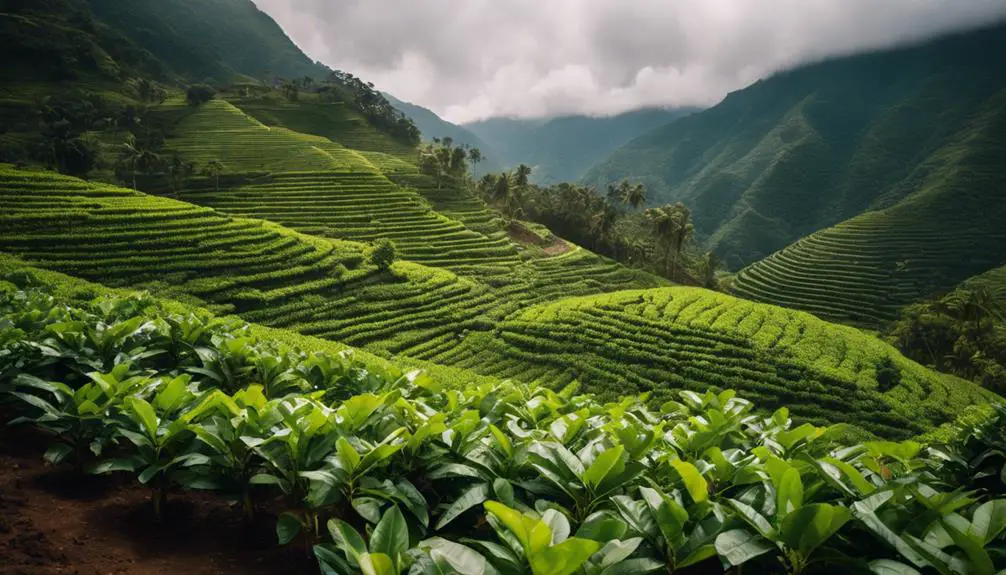
If you want to grow top-notch Arabica coffee, you need to understand its preferred climate. Arabica thrives in specific temperature and rainfall conditions, crucial for producing high-quality beans.
Getting these factors right is key to cultivating exceptional Arabica coffee.
The Climate Arabica Loves: Understanding Temperature and Rainfall Needs
You’re about to uncover the secrets of creating the perfect environment for Arabica coffee growth. Understanding the temperature and rainfall needs is essential for cultivating top-notch Arabica beans.
Let’s start by considering the following key factors:
- Altitude: The higher, the better!
- Climate: Consistent temperatures for optimal growth.
- Rainfall: Just the right amount is crucial.
- Soil quality: Rich and well-draining soils are a must.
- Sunlight exposure: Balanced shade and sunlight play a vital role.
The Significance of Altitude in Arabica Coffee Production
Exploring the impact of altitude on Arabica coffee production reveals the crucial role elevation plays in determining the quality and flavor profile of the beans.
- Arabica beans thrive at higher altitudes
- Altitude affects the acidity and sweetness of the coffee
- High altitudes slow down the maturation process, enhancing flavor
- Cool temperatures at altitude support gradual bean development
- Ideal altitude ranges vary by location
Soil Types and Their Impact on Arabica Coffee Quality
Elevation significantly influences the quality and flavor of Arabica coffee beans, and similarly, different soil types play a crucial role in determining the overall quality of the coffee produced. The composition of the soil directly impacts the nutrients available to the coffee plants, influencing the flavor profile and quality of the beans.
Understanding the soil types can help optimize cultivation practices for superior Arabica coffee production.
| Soil Type | Description | Impact on Coffee Quality |
|---|---|---|
| Volcanic | Rich in minerals | Enhances flavor |
| Loamy | Well-draining | Promotes balanced growth |
| Sandy | Good aeration | Lighter body |
| Clayey | Retains moisture well | Richness in flavor |
| Red-Yellow | Moderately fertile | Mellow taste |
The Delicate Dance with Climate: Challenges and Adaptations
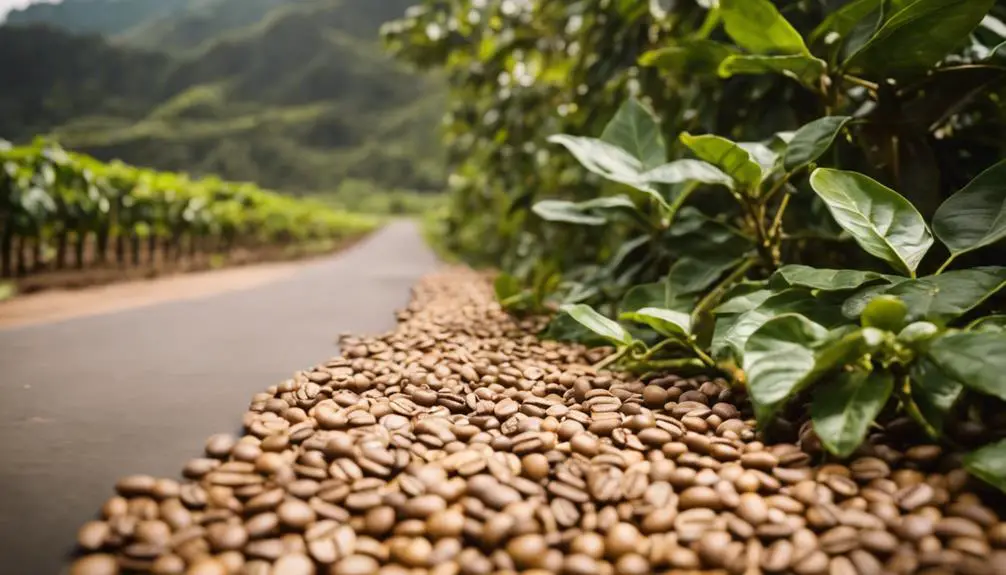
You face challenges as climate change impacts Arabica coffee production, making it crucial to adapt to the changing conditions.
Economic vulnerabilities arise alongside opportunities in the delicate dance between the Arabica coffee industry and the evolving climate.
It’s essential to navigate these challenges skillfully to ensure the sustainability and resilience of Arabica coffee growing regions.
Facing the Future: Climate Change and Arabica Coffee
As you explore the challenges and adaptations of Arabica coffee in the face of climate change, consider the following points:
- Rising temperatures affecting coffee production
- Shifts in precipitation patterns impacting crop yields
- Strategies for sustainable farming practices
- Importance of shade-grown coffee for climate resilience
- Innovation in breeding heat-tolerant coffee varieties
The Impact of Global Warming on Arabica Coffee Regions
Facing the challenge of global warming, Arabica coffee regions are navigating a delicate dance with climate fluctuations to ensure their future sustainability.
As temperatures rise and weather patterns shift, the conditions for growing high-quality Arabica coffee are at risk. Innovations in sustainability practices and adaptive strategies are crucial for the industry’s resilience.
Explore the table below to grasp the current impact of global warming on Arabica coffee regions.
| Climate Change Impact | Challenges | Solutions |
|---|---|---|
| Temperature Variability | Reduced yields | Shade-grown cultivation |
| Changing Rainfall Patterns | Increased pests and diseases | Water-efficient irrigation systems |
| Extreme Weather Events | Crop damage | Agroforestry practices |
Adapting to Change: Strategies for Sustainability
Navigating the evolving climate challenges, Arabica coffee regions are implementing innovative strategies to ensure long-term sustainability in the face of global warming.
- Introducing shade-grown coffee plantations
- Utilizing water-efficient irrigation systems
- Implementing agroforestry practices
- Developing heat-resistant coffee plant varieties
- Collaborating with climate scientists for data-driven decision-making
Economic Vulnerabilities and Opportunities
As you consider the economic vulnerabilities and opportunities in Arabica coffee growing regions, remember the delicate balance between market dynamics and farmer livelihoods. Explore how Fair Trade and Direct Trade initiatives can support and uplift Arabica regions in the face of challenges and changes.
- The fluctuating price of Arabica coffee
- The impact on farmer livelihoods
- The role of Fair Trade in ensuring fair compensation
- The benefits of Direct Trade relationships
- Strategies for adapting to market shifts
Market Dynamics: The Price of Arabica Coffee and Farmer Livelihoods
The interplay between Arabica coffee prices and farmer livelihoods highlights the intricate relationship influenced by market dynamics and climate conditions. In the table below, observe the connection between price fluctuations and their impact on farmer income levels.
| Price of Arabica Coffee | Farmer Livelihoods |
|---|---|
| High | Prosperous |
| Fluctuating | Unstable |
| Stable | Sustainable |
| Low | Struggling |
The Role of Fair Trade and Direct Trade in Supporting Arabica Regions
In considering the intertwined relationship between Arabica coffee prices and farmer livelihoods, the implementation of Fair Trade and Direct Trade emerges as pivotal in bolstering support for Arabica growing regions.
- Fair Trade: Ensuring fair wages for farmers
- Direct Trade: Establishing direct relationships between farmers and buyers
- Transparency: Providing visibility into the coffee supply chain
- Sustainability: Supporting environmentally friendly practices
- Community Development: Investing in local communities
Innovations and Trends in Arabica Coffee Cultivation
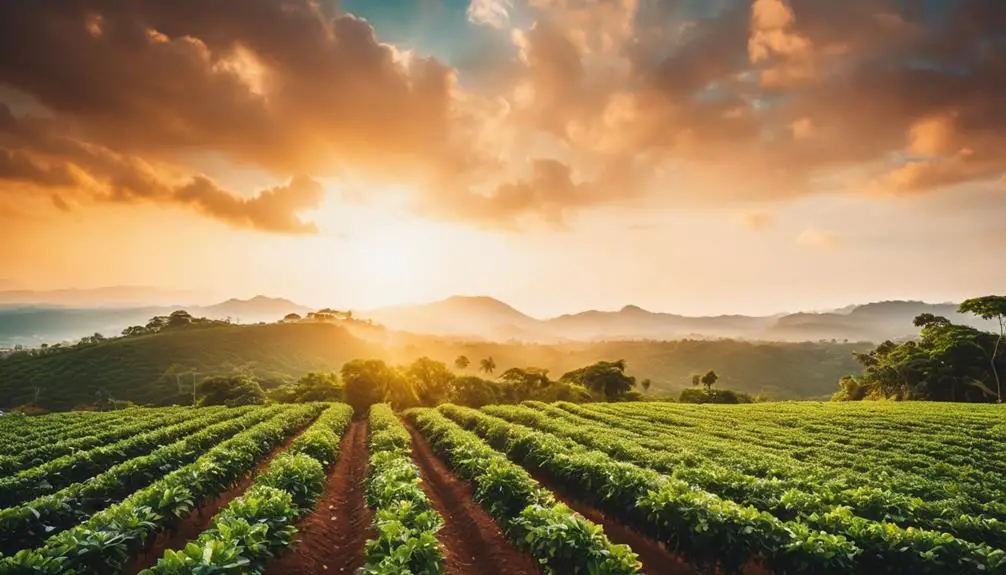
You’ll discover how technological advances are revolutionizing Arabica coffee farming, shaping its future in exciting ways.
Sustainable practices are also taking center stage, paving the way forward for Arabica coffee cultivation.
It’s a time of innovation and transformation in the world of Arabica coffee production.
Technological Advances: Shaping the Future of Arabica Coffee Farming
You’re about to explore the cutting-edge innovations revolutionizing Arabica coffee farming. From precision agriculture techniques to genetic research advancements, these trends are reshaping the industry. Get ready to witness the future of Arabica coffee cultivation unfold before your eyes.
- Advanced drones mapping out coffee fields
- Genetic modifications enhancing plant resilience
- Smart irrigation systems optimizing water usage
- Automated harvesting machines increasing efficiency
- Data analytics improving crop management
Precision Agriculture and Its Impact on Arabica Coffee Quality
Amplifying the quality of Arabica coffee through precision agriculture techniques is revolutionizing the future of coffee cultivation.
- Drones scanning coffee fields for precise nutrient application.
- Soil sensors optimizing watering schedules for each coffee plant.
- AI systems analyzing data to predict optimal harvest times.
- Robotic harvesters selectively picking only the ripest coffee cherries.
- Controlled environment systems ensuring ideal growing conditions year-round.
Genetic Research and Biotechnology: Enhancing Resilience and Flavor
Enhancing the resilience and flavor of Arabica coffee through genetic research and biotechnology is a cutting-edge approach shaping the future of coffee cultivation.
- Utilizing advanced genetics to develop disease-resistant Arabica coffee varieties
- Enhancing flavor profiles through biotechnological interventions
- Creating bespoke cultivation techniques based on genetic data
- Improving yield and quality through targeted genetic modifications
- Ensuring sustainability by developing environmentally friendly biotechnologies
Sustainable Practices: The Path Forward for Arabica Coffee
When it comes to sustainable practices in Arabica coffee cultivation, there are several key points to consider. Let’s explore some of these innovative trends shaping the future of coffee farming:
- Organic Farming and Conservation Agriculture
- Water Management for Sustainability
- Soil Conservation Techniques
- Biodiversity Preservation
- Climate-Smart Agriculture
Organic Farming and Conservation Agriculture: Benefits Beyond the Bean
Exploring the realm of organic farming and conservation agriculture in Arabica coffee cultivation reveals benefits that extend far beyond the coffee bean itself.
- Enhanced soil fertility
- Increased biodiversity
- Reduced environmental impact
- Improved water retention
- Preservation of ecosystem balance
Water Management and Soil Conservation: Ensuring the Future of Arabica Coffee
Water management and soil conservation are critical components for ensuring the long-term sustainability and productivity of Arabica coffee cultivation.
- Implementing precision irrigation systems to optimize water usage.
- Introducing cover crops to prevent soil erosion.
- Utilizing compost and organic matter to enhance soil fertility.
- Introducing terracing techniques to reduce water runoff.
- Implementing agroforestry practices to promote biodiversity and soil health.
Conclusion
As you explore the premier Arabica coffee growing regions, remember that terroir plays a key role in shaping the flavors of this beloved bean.
Did you know that Brazil alone produces over one-third of the world’s Arabica coffee? This statistic highlights the importance of understanding the unique conditions that contribute to the quality and taste of coffee from different regions.
Keep savoring those distinct flavors!

